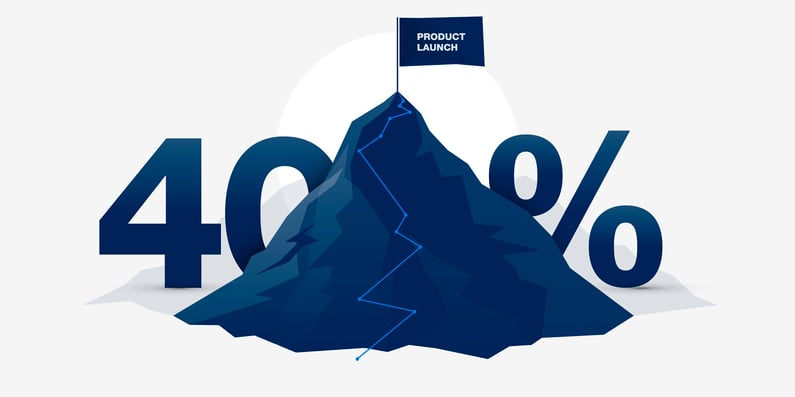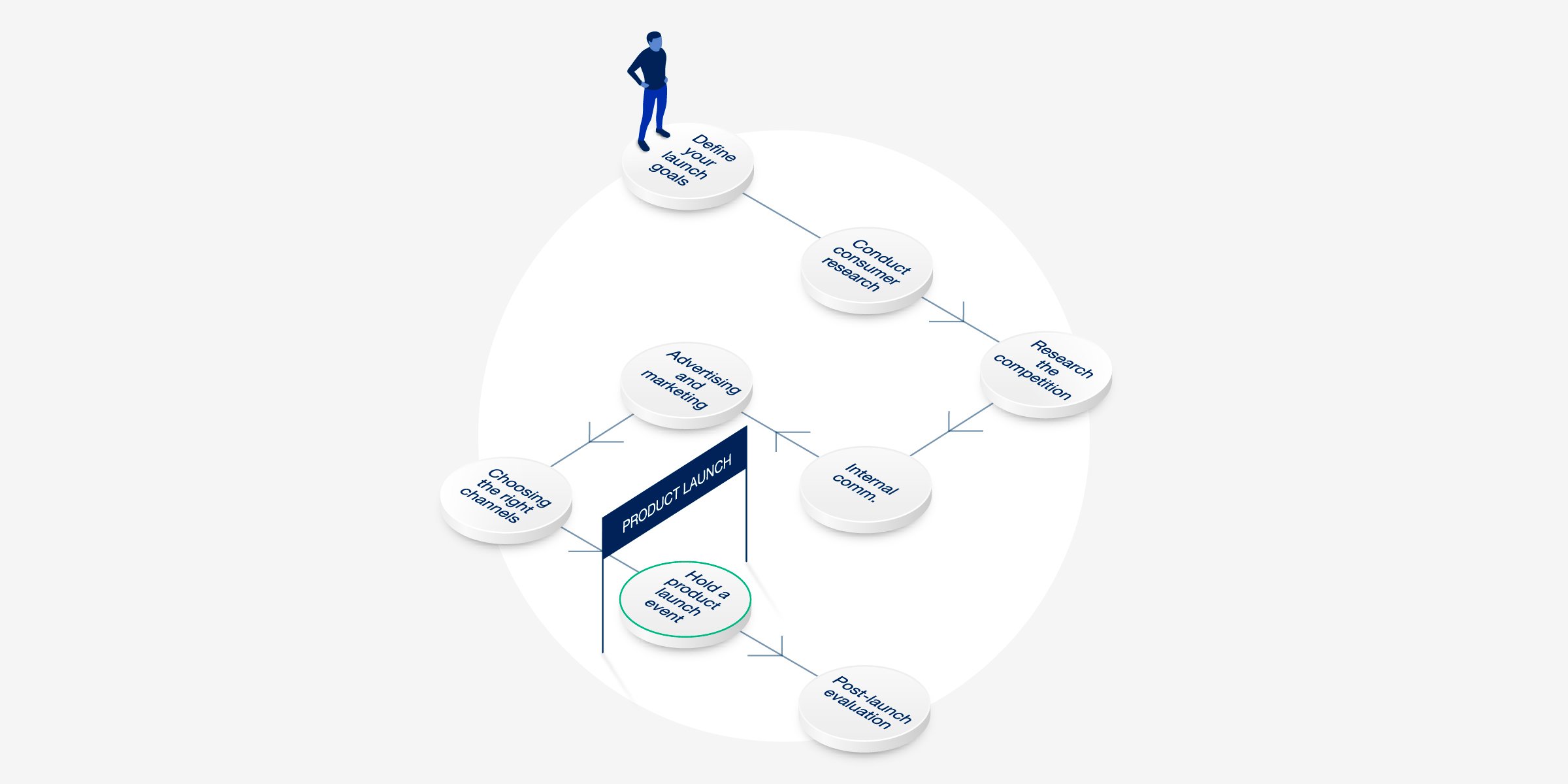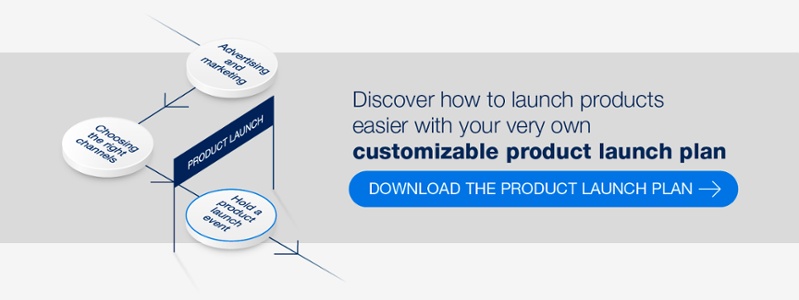According to the Marketing Research Association, only 40% of products that are developed actually make it to market [I]. Of those, only 60% generate positive revenue. So where do brands go wrong when launching a new product? Is it the product, or is it the product launch strategy? Is it the failure to understand the wants and needs of the target market? Or is a competitor’s product just better?
Consider this comprehensive guide as a sort of roadmap. The guidelines and product launch tips that follow will cover everything from the schedule of your go-to-market strategy to understanding your customers, knowing what the competition is doing, and holding a product launch event.

Planning your product launch - why a product launch strategy is important
There are certainly a lot of questions to ask and factors to consider when developing a product launch strategy. But one question that should never be asked is whether or not you actually need to create a product launch strategy.
The answer is a strong, definitive YES.
In today’s competitive marketplace, a product release without an adequate product launch strategy and accompanying marketing faces a much greater chance of failure. Many experts state that it doesn’t matter how good your product is — without a strong product launch, the chances of success diminish drastically.
It’s also important to realize that a successful product launch strategy has many facets. Ignoring one or more can doom your product launch. For example, many brands focus all their time and resources on the product launch event but fail to consider internal communication and pre-launch planning.
And let’s not forget the benefits of pulling off a pitch-perfect product launch. A strong ROI and increased sales revenue are just some of the rewards. A company also benefits from greater brand recognition and a stronger reputation in the marketplace. Additionally, you expand your market reach and catch the attention of consumers who might not have been aware of your brand prior to the product launch. This, of course, opens the door to new business leads and, consequently, more revenue.
So, now that you know the importance of a product launch strategy, where do you begin?
6 steps to help you create a product launch strategy
- Define your launch goals
- Conduct consumer research
- Research the competition
- Pay attention to internal communication
- Create advertising and marketing plan
- Hold a product launch event
Define your launch goals
What are you expecting to gain from your product launch? Are you simply focused on sales? Or are you looking to build a stronger relationship with your customer base? Are you seeking to show why your product is better than a similar product offered by a competitor? Maybe a combination of all three?
Defining your goals, and, following that, considering your target audience, serves to lay the initial groundwork for your product launch strategy. If it helps, consider using the SMART goals example to facilitate the thought process.
- S - Specific - Make your goals specific.
- M - Measurable - How will you measure your progress?
- A - Attainable - Is this goal actually attainable?
- R - Relevant - Is this goal relevant to your brand values and long-term objectives?
- T - Time-based - Are you giving yourself enough time to achieve this goal?
Conduct consumer research
Your consumer research efforts should be ongoing, regardless of if and when you are releasing new products. But for the purposes of a product launch strategy, you need to not only better define your target audience for this specific product, but also understand their wants, needs and pain points so that you know how best to market the product to your target audience.
Does the product provide value to your customers? The way to answer that question is to create a definitive buyer persona so that you know exactly who you are delivering your message to.

You need to know what features your customers will appreciate the most. You need to know what marketing channels they will be most receptive to. And you need to know how to tell a story with your product launch marketing that will resonate with them.
Research the competition
Knowing what the competition is doing is also important. Without being aware of competitor products and marketing efforts, you may end up launching a product or conducting a marketing campaign that just isn’t on the same level as a competitor.
Research their websites, their social media pages, and their product success and failures. See what is working for them and what isn’t. What features do their products offer, and how do they benefit the consumer? How is your product different? What makes it better?
When creating your product launch strategy, be sure to provide specific examples as to why your product is better than that of a competitor. Without identifying these key points, your target audience may not be inclined to consider your product when there is already a feasible alternative on the market. For that, an explainer video that can be easily shared on your channels might just be the solution.
The importance of internal communication
Communication is always an integral component of any business function and planning strategy. A product launch is no exception. Your organization is comprised of several departments that will all play a role in the product launch. Strong, consistent and efficient communication amongst all involved teams will better enable you to develop a product launch strategy.
Coordinating with your teams, providing instruction within a reasonable time frame, keeping everyone on the same schedule, and making sure the messaging and goals are understood by everyone within the organization — these things ensure your strategy has a much greater chance of success and that nothing is forgotten or left out.
Advertising and marketing
Creating a marketing plan can be just as intensive and time-consuming as the overall product launch strategy. It certainly isn’t something that can be considered a minor detail. You’ll need your marketing team to craft stories and persuasive messaging that are relevant to your brand values and consistent across all marketing channels.
The story of the product should explain to consumers why they need the product, and why they should choose your product over the competition. This isn’t always an easy thing to do — too often, marketing or the entire organization forgets to view things from the perspective of the consumer, and instead creates messaging that misses the mark.
Stay focused on customer pain points and product benefits, and you’ll be truer to the development of a viable marketing strategy that showcases your product without focusing too much on selling the product. Essentially, you want your advertising to connect with your audience without being too salesy.
You might also like: "6 things you need to consider when advertising your new product launch"
Choosing the right channels
What marketing channels will work best for achieving your goals? Email marketing, videos, social media marketing and other digital marketing strategies are pretty much the norm these days, but how you leverage these channels can make a huge difference in the success of your product launch strategy.
For example, Facebook offers a great advertising platform with advanced targeting capabilities. You can choose from several intuitive options to narrow down the target demographic, ensuring you’re not wasting your advertising budget on an audience that doesn’t care about your product.
Videos are also an extremely impactful way to tell a story. They are also easily shareable, which can serve to expand your marketing reach in a cost-effective manner. Consider combining the power of video with the engagement potential of social media marketing with a social media video. It’s a great way to take your social media marketing up a notch and provide your audience with captivating imagery that stands out from competitors.
Hold a product launch event
Coinciding with your product launch strategy and your marketing campaign is the product launch event. Holding a product launch event serves to build awareness as well as generate buzz and anticipation during the pre-launch efforts.
Start planning your product launch event at least 4-6 months in advance, so that you aren’t rushing to take care of anything at the last minute. You’ll need time to generate marketing materials, secure a location for the event, plan for food and entertainment, and take care of many smaller details that may not seem like much but which your audience will certainly remember and be talking about for quite some time post-launch.
You might also like: "Your next product launch event: ideas, plans and execution"
You might also want to consider holding a virtual event as opposed to a physical event. Over the past few years, virtual events have increased in frequency and popularity. Not only are they more cost-efficient for a brand, but you can also hold them for a much larger audience.
Advancements in technology allow you to provide your attendees with unique opportunities to view your products, for example in a digital showroom. And with the use of Location Library, you can showcase your products in unique and engaging settings that would never be possible with an ordinary photoshoot.
Why some product launches fail and how to recover from a failed launch
As mentioned at the beginning of this article, many product launches fail. It would be nice if this never happens to you, but the unfortunate reality is that at some point it probably will. The development of a strong product launch strategy will certainly minimize that risk, but it is never 100% fail-proof.
You might also like: "Why most product launches fail: 5 things you wish you'd known earlier"
So, if you do experience a failed product launch, don’t despair. You definitely aren’t alone, and you will be able to recover. The first thing is to accept what has happened and attempt to discover what went wrong so you can learn from your mistakes and avoid repeating them.
Most product launch failures can be attributed to one of five things:
- Timing
- Marketing and advertising
- Failure to understand consumer needs
- Focusing on the wrong market or poor positioning
- Pricing
Sometimes it’s not just one of the above, but several. And while the above factors are the most common reasons for a product launch failure, they are by no means all-inclusive. The reason for a failure could be something you might never have thought of before, such as a website that is difficult for visitors to navigate.
When conducting your research and analyzing what might have gone wrong, be sure to include the audience in your efforts. Ask your customer base what they didn’t like about the product. Ask them how they felt about your marketing. Was it informative, or was it lacking? Do they prefer the product of a competitor? Why?
There are plenty of questions you could and should ask based on your own unique situation, and the answers could provide you with insight that will enable you to perform much better with your next product launch strategy.

In conclusion
It’s important to remember that no two product launches will ever be the same. The timing, economic factors, changing consumer wants, needs, and expectations, and what the competition is doing will all affect how well a particular product does.
That’s why it’s important to leave yourself plenty of time for research, planning and sales forecasting. Additionally, you must always clearly define your goals as well as outline the strategy for your pre-launch, product launch and post-launch.
Be prepared to make numerous changes along the way and to react to sudden changes in the marketplace. At the same time, welcome insight from team members within your organization, especially if you are customer-centric. With the mindset of providing the best possible service and customer experience for your target market, your employees may have keen ideas on how to improve your product launch strategy and the related messaging of your marketing campaign.
As you can see, a product launch strategy requires a lot of time and resources, but a successful product launch makes it all worth it.
[I] http://www.marketingresearch.org/article/importance-process-new-product-development
